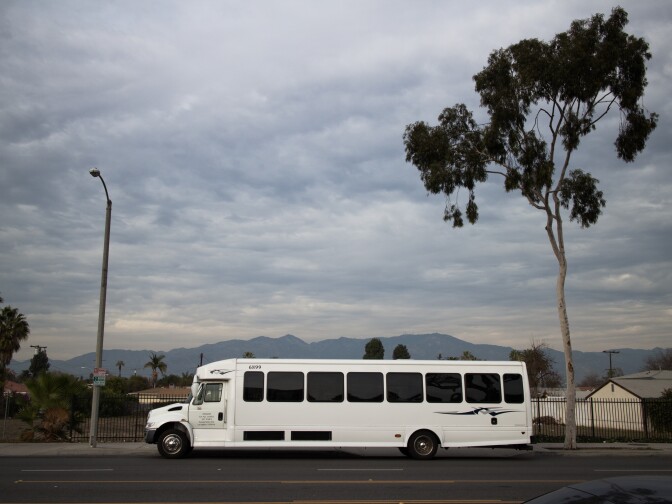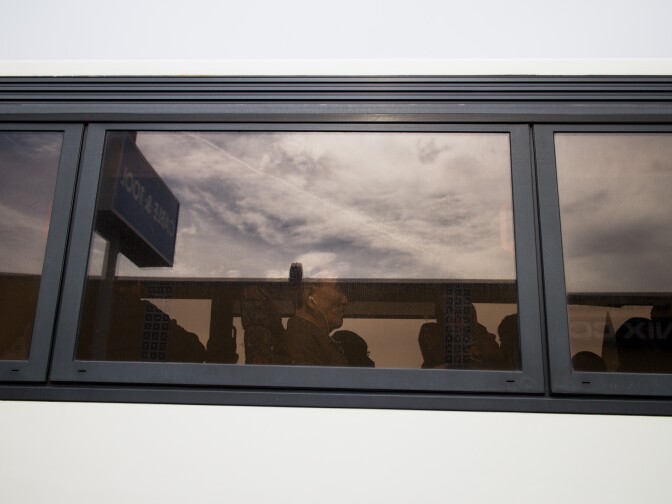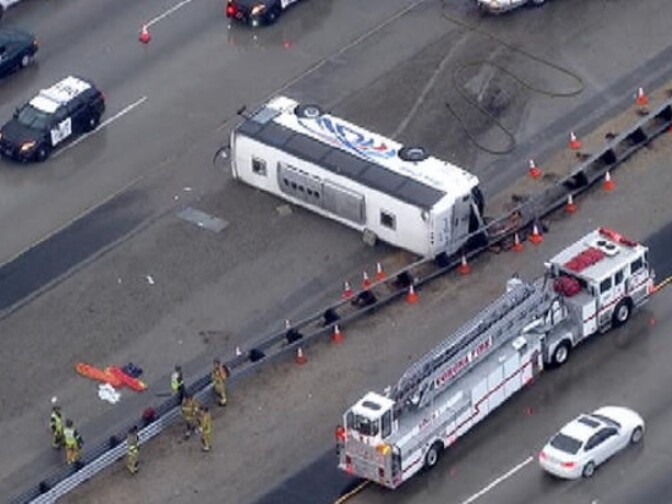Truth matters. Community matters. Your support makes both possible. LAist is one of the few places where news remains independent and free from political and corporate influence. Stand up for truth and for LAist. Make your year-end tax-deductible gift now.
This archival content was originally written for and published on KPCC.org. Keep in mind that links and images may no longer work — and references may be outdated.
Tour bus safety: Regulators struggle to keep up with casino bus boom
This is the first of two KPCC stories on safety and the burgeoning business of casino tour bus brokers. As the buses have grown in popularity, regulation has become more lax, with dangerous consequences for passengers and other drivers on the road. Here's a link to part two.
Every few minutes on a busy street in Rosemead, in the San Gabriel Valley, a crowded tour bus pulls over, its door opens to allow passengers to get off and others to get on. As soon as one packed bus leaves, it doesn’t take long for another to arrive.
This isn’t a bus depot, or even a real bus stop. It’s just one of the many local streets in Los Angeles and Orange County where gamblers know they’ll be able to catch a cheap ride to casinos.
Since 2000, curbside tour buses have become more commonplace on Southern California’s freeways. They can now be found in almost every casino parking lot.
But a recent slew of accidents has raised questions about the regulation and safety of curbside buses, especially those that go to casinos.
RELATED: Is the tour bus you're taking on California's watch list?
In December, three separate accidents involving casino buses killed one person, and injured 57, over a five-day period.
At the casino bus stop in Rosemead – and another in Koreatown — KPCC found half the buses that stopped on a recent afternoon were listed on a federal watch list, with drivers who falsified records or skimped on maintenance. (All of the buses had a satisfactory record with the Federal Motor Carrier Safety Administration, or FMCSA, the federal agency that regulates tour buses).
The accidents haven’t slowed down business for Anthony Wen, a tour bus broker in the San Gabriel Valley. People are so eager to get a seat on one of his crowded buses that even gray-haired ladies run when they see a bus arrive.
“I used to be one of those people that ran,” said Wen.
Now Wen watches people run from the booth at a McDonald’s next to where his buses stop.
“It’s basically my office,” said Wen, whose official title is General Manager of Double Dragon, Inc.
He said he operates up to 15 buses daily, which deliver up to 600 passengers to local casinos. He makes money charging gamblers around $7 a ride. The casinos welcome his buses as long as he brings them what’s known as “quality players,” those who will keep rolling the dice for hours.
“Everybody’s jumping on the bandwagon,” said Wen. “Bringing people on a bus is very profitable for a casino or else they wouldn’t do it.”
Researcher: Buses are at 95 percent of California casinos
The California tribal gaming industry is a $7 billion a year business in California, and almost every casino relies on tour buses to deliver customers, according to Brian Antolin, a researcher and consultant who has studied the casino bus business.
“If they didn’t have them, most of them would shut down, if we we’re to be very honest about it,” said Antolin.
Hard numbers are hard to come by, but Antolin estimates that scheduled bus service is available at 95 percent of California casinos.
“In certain cases, especially in Asian gaming, it is the lifeblood, because you have people who keep spending hundreds of dollars each day who go five or six days a week,” said Antolin.
Like the airline industry, buses were deregulated in the 1980s, but it wasn’t until the Internet age that buses exploded in popularity, which was around the same time the tribal gaming craze began.
Between 1999 and 2012, 67 Indian casinos opened in California, according to U.S. Sen. Dianne Feinstein.
“It was really after the turn of the century when we started to see the acceptance of gambling as a regular pastime, the Asian population with more discretionary income, and, frankly, casinos wanting people in their building," said Timothy Fong, co-director of the UCLA Gambling Studies Program. "People here in California are spread throughout and without mass transit it became to me, a very obvious business model of buses.”
Fong said prior to casino buses he heard reports of "gypsy taxis" that would pick up gamblers on street corners and ferry them to local card rooms.
Fong has mixed feelings about the rise of casino buses. He has no doubt a significant portion of riders are problem gamblers, the kinds he sees in his clinic.
“It’d be like if you created buses for crack addicts to go to the crack house," said Fong. "No one would say that’s a good thing, right?”
But he also knows there are a lot of people, like his housekeeper, who want to gamble from time to time and enjoy taking the buses.
“She likes to go out twice a year, and she loves it,” said Fong. “She goes out with her family. It’s a whole party atmosphere, and she doesn’t have to drive. So that’s how it should be done, in a responsible manner.”
Passengers not concerned?
When we asked passengers if they were concerned about safety, they said they weren't. In fact, they were much more worried that talking to reporters would scare away the buses.
We contacted every major casino in the area, and none would speak for this story. They generally disavowed any connection to the buses.
The Pala Casino in San Diego County provided a statement to KPCC:
Pala Casino Spa Resort does not own or operate any of the tour buses that bring guests to our property.We contract with each independent tour bus company for that service. As part of those contracts, we coordinate with all state regulatory agencies and the bus companies to ensure the buses are regularly inspected and maintained for maximum guest safety.
“Safety is your reputation,” he said. “If you’re running an unsafe bus, you’ll either lose your contract or the customers won’t ride your bus.”
Still, Wen admits he operates on razor-thin profit margins. He estimates there are up to a 100 other companies like his, just in the San Gabriel Valley alone, and they all try to steal his business by charging lower prices.
“It happens everyday,” said Wen. “Some people actually say they make no money. Some people lose money.”
Feds want to regulate bus brokers
Slim profit margins can make skimping on safety very tempting, according to Katherine Harvey-Lee, a plaintiff’s attorney who has represented bus accident victims.
"Honestly, it’s the wild west out there, with these guys competing for who can provide the lowest price possible,” said Harvey-Lee.
It also doesn’t help that brokers like Wen are completely unregulated, something federal authorities say is a glaring loophole.
“Allow us to regulate passenger ticket sellers,” FMCSA director Anne Ferro told lawmakers at a June 2011 hearing in Washington. “We refer to them as brokers. We currently regulate freight brokers. We regulate household goods brokers. We have no authority over passenger carrier brokers.”
This week, FMCSA is adopting new regulations allowing them to shut down any bus company that has a history of purposely violating safety rules. The new rules don’t address bus brokers.














